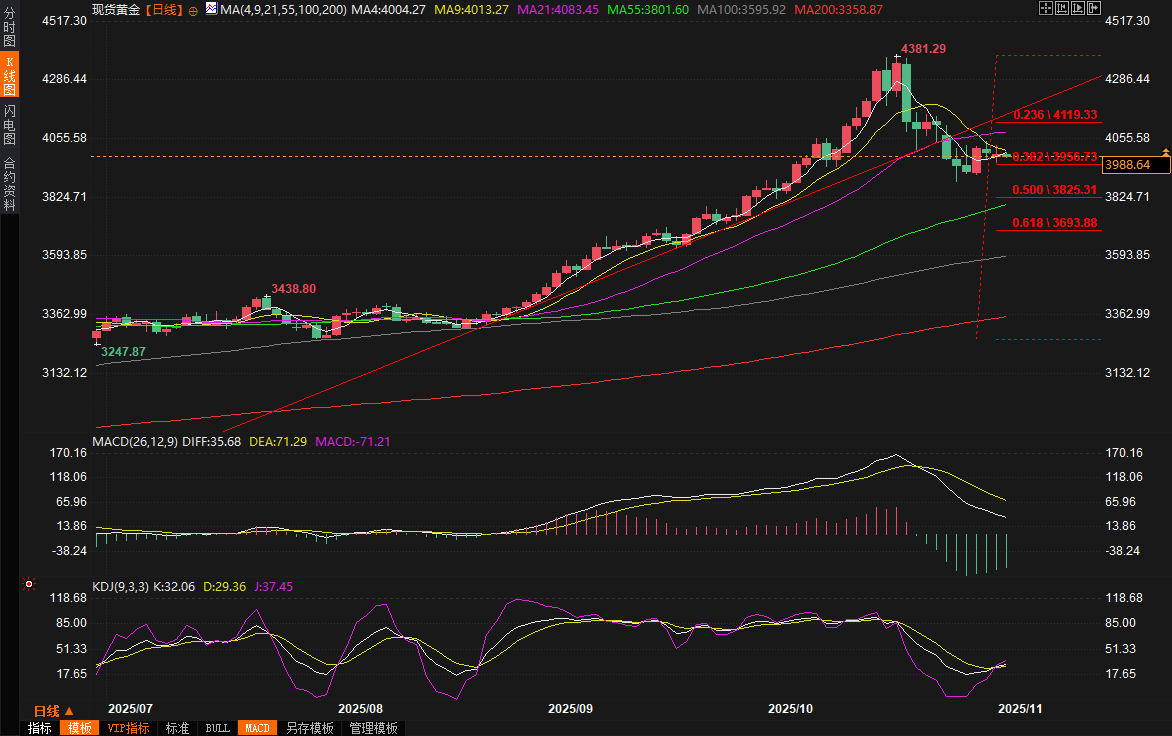Gold Trading Alert: The Fed's "hawkish-dove" debate intensifies, putting short-term pressure on gold prices, but the long-term logic remains unchanged.
2025-11-04 07:21:41

The Fed's "hawk-dove war" escalates: the probability of a rate cut plummets to 65%, Powell pours cold water on the idea, and Milan Goolsby responds sharply.
The Federal Reserve cut interest rates by 25 basis points to a range of 3.75%-4.00% last week as expected. This was the second rate cut this year, but it was also the first time that Chairman Powell explicitly stated that "another rate cut this year is not a certainty."
Traders' expectations for a December rate cut plummeted from nearly 100% a week ago to 65.3%, directly causing non-yielding gold to lose its support from declining interest rates. Powell emphasized last week that inflation remains above the 2% target, and while the economy has slowed, it is still growing steadily, requiring caution regarding further easing. Even more shocking to the market was the rare occurrence of a 10-2 vote within the Federal Reserve, a vote unseen since 1990, revealing a deep division behind the seemingly unrelated hawkish and dovish stance.
Dovish representative and board member Milan reiterated his advocacy for a significant interest rate cut on Monday, arguing that current policies are "too restrictive," that interest rate-sensitive sectors such as housing are weak, that the private lending market is under pressure, and that the stock market boom does not prove that monetary policy is sufficiently loose. He even advocated for a gradual cut of 50 basis points until rates are well below the current neutral rate.
On the other hand, hawks, such as Chicago Fed President Goolsby, are “nervous” about inflation, noting that it has been above target for four and a half years and could accelerate in the remainder of 2025.
Kansas City Fed President Schmid emphasized that signs of easing in financial markets are evident, with the stock market near historical highs and corporate bond spreads extremely narrow, making further rate cuts too risky. San Francisco Fed President Daly, while supporting last week's rate cut, remains "open" to the December meeting, requiring more evidence of a deteriorating labor market.
Federal Reserve Governor Cook warned that excessively high interest rates could lead to a sharp deterioration in the labor market, while excessively low interest rates could cause inflation expectations to decouple.
The internal divisions are so intense that Shaun Osborne, chief currency strategist at Scotiabank, bluntly stated, "In my years of observing the market, I have never seen such a significant public disagreement among Federal Reserve policymakers." This "hawk-dove battle" directly undermines market confidence in the easing path, with gold, as a "benefiter of low interest rates," bearing the brunt.
The government shutdown may be the longest in history, and the data vacuum amplifies uncertainty.
The US government shutdown has lasted for a month and this week may be the longest in history, with the Bureau of Labor Statistics suspending the release of all key data, including the non-farm payroll report.
Investors are now focusing on Wednesday's ADP private sector employment data and ISM purchasing managers' index, hoping to glean clues about the Federal Reserve's policy.
The ISM Manufacturing PMI fell to 48.7 in October from 49.1, marking the eighth consecutive month in contraction territory, with weak new orders and supply chain delivery times further exacerbated by the extension of tariffs.
Although Capital Economics economist Thomas Ryan believes the decline was mainly driven by production fluctuations, with new orders and employment sub-sectors showing some recovery, the data vacuum has significantly increased the risk of policy misjudgment.
Kelly Kowalski, head of investment strategy at MassMutual, stated bluntly, "The market had previously anticipated a significant rate cut by the Fed, but Powell poured cold water on this, and the lack of data has raised questions about the path of rate cuts next year." This data vacuum not only amplified internal divisions within the Fed but also directly pushed the dollar index higher for four consecutive days, reaching 99.89 intraday, a new high since August. The stronger dollar further suppresses gold's pricing power, making it difficult for gold prices to break through the $4,000 resistance level in the short term.
Global macroeconomic undercurrents are surging: the end of China's duty-free policy, a strong dollar, and a surge in corporate bonds pose multiple constraints to gold bulls.
While the long-term fundamentals for gold remain unchanged, it faces multiple negative factors in the short term. First, China, as the world's largest gold consumer market, abruptly ended long-term tax exemptions for some retailers last Saturday, directly dampening the buying frenzy and potentially significantly weakening physical demand.
Secondly, the US dollar index remains strong, and the euro fell to 1.1505 against the dollar, its weakest level since August. The dollar also rose sharply against the Swiss franc and the Japanese yen. Driven by interest rate differentials, it is unlikely that the dollar will see a turning point in the short term.
Third, there has been a surge in US corporate bond issuance. Meta issued a record $30 billion in bonds last week, and Alphabet issued over $17 billion in bonds on Monday. Tech giants are vying to lock in low interest rates, indirectly diverting funds and pushing up US Treasury yields.
The 10-year Treasury yield closed at 4.107%, while the 30-year yield rose to 4.689%, and the spread between the two-year and 10-year yields widened to 51 basis points, indicating market optimism about the long-term economic outlook.
Tom di Galoma, Managing Director of Mischler Financial Group, pointed out that companies shorted US Treasuries heavily before issuance to hedge borrowing costs, causing bond prices to fall and further pushing up yields. Non-yielding gold is under significant short-term pressure due to the triple squeeze of high interest rates, a strong dollar, and capital outflows from corporate bonds.
Summary: A renewed upward trend may occur after the data becomes clearer; the foundation for a long-term bull market remains intact. Whether gold can hold the $4,000 level will directly determine whether it continues to consolidate or breaks down in the short term.
Wednesday's ADP data and ISM services PMI will be key catalysts. If employment and manufacturing are weaker than expected, dovish voices may regain the upper hand, increasing the probability of a December rate cut, and gold prices are expected to recover quickly. Conversely, if the data is resilient, hawkish rhetoric will continue to dominate, and gold may test the $3,800 support level.
However, it should be emphasized that seasonal weakness, policy noise from China, and the temporary strengthening of the US dollar are all short-term disturbances. The long-term logic of global geopolitical risks, rising inflation, and central bank gold purchases remains unchanged. Ole Hansen points out: "None of these factors can change the long-term trend."
Investors should closely monitor this week's data and news related to the US government shutdown. In the short term, they should adopt a range-bound trading strategy, while in the medium to long term, they can still strategically allocate gold.

(Spot gold daily chart, source: FX678)
At 07:18 Beijing time, spot gold was trading at $3991.08 per ounce.
- Risk Warning and Disclaimer
- The market involves risk, and trading may not be suitable for all investors. This article is for reference only and does not constitute personal investment advice, nor does it take into account certain users’ specific investment objectives, financial situation, or other needs. Any investment decisions made based on this information are at your own risk.





















